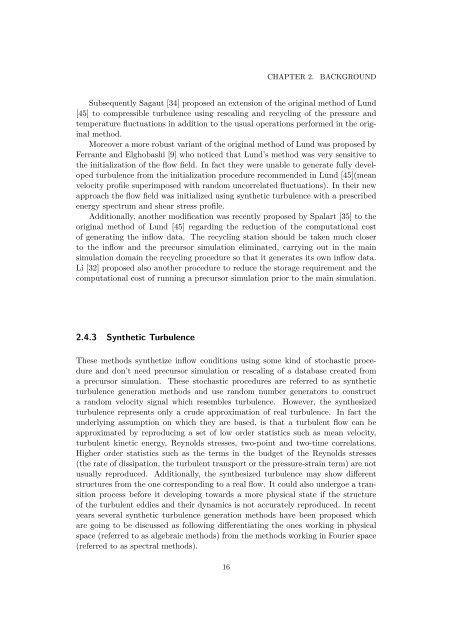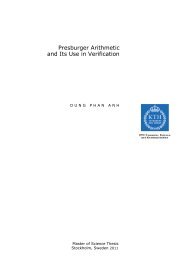Synthetic Inflow Condition for Large Eddy Simulation (Synthetic - KTH
Synthetic Inflow Condition for Large Eddy Simulation (Synthetic - KTH
Synthetic Inflow Condition for Large Eddy Simulation (Synthetic - KTH
Create successful ePaper yourself
Turn your PDF publications into a flip-book with our unique Google optimized e-Paper software.
CHAPTER 2. BACKGROUND<br />
Subsequently Sagaut [34] proposed an extension of the original method of Lund<br />
[45] to compressible turbulence using rescaling and recycling of the pressure and<br />
temperature fluctuations in addition to the usual operations per<strong>for</strong>med in the original<br />
method.<br />
Moreover a more robust variant of the original method of Lund was proposed by<br />
Ferrante and Elghobashi [9] who noticed that Lund’s method was very sensitive to<br />
the initialization of the flow field. In fact they were unable to generate fully developed<br />
turbulence from the initialization procedure recommended in Lund [45](mean<br />
velocity profile superimposed with random uncorrelated fluctuations). In their new<br />
approach the flow field was initialized using synthetic turbulence with a prescribed<br />
energy spectrum and shear stress profile.<br />
Additionally, another modification was recently proposed by Spalart [35] to the<br />
original method of Lund [45] regarding the reduction of the computational cost<br />
of generating the inflow data. The recycling station should be taken much closer<br />
to the inflow and the precursor simulation eliminated, carrying out in the main<br />
simulation domain the recycling procedure so that it generates its own inflow data.<br />
Li [32] proposed also another procedure to reduce the storage requirement and the<br />
computational cost of running a precursor simulation prior to the main simulation.<br />
2.4.3 <strong>Synthetic</strong> Turbulence<br />
These methods synthetize inflow conditions using some kind of stochastic procedure<br />
and don’t need precursor simulation or rescaling of a database created from<br />
a precursor simulation. These stochastic procedures are referred to as synthetic<br />
turbulence generation methods and use random number generators to construct<br />
a random velocity signal which resembles turbulence. However, the synthesized<br />
turbulence represents only a crude approximation of real turbulence. In fact the<br />
underlying assumption on which they are based, is that a turbulent flow can be<br />
approximated by reproducing a set of low order statistics such as mean velocity,<br />
turbulent kinetic energy, Reynolds stresses, two-point and two-time correlations.<br />
Higher order statistics such as the terms in the budget of the Reynolds stresses<br />
(the rate of dissipation, the turbulent transport or the pressure-strain term) are not<br />
usually reproduced. Additionally, the synthesized turbulence may show different<br />
structures from the one corresponding to a real flow. It could also undergoe a transition<br />
process be<strong>for</strong>e it developing towards a more physical state if the structure<br />
of the turbulent eddies and their dynamics is not accurately reproduced. In recent<br />
years several synthetic turbulence generation methods have been proposed which<br />
are going to be discussed as following differentiating the ones working in physical<br />
space (referred to as algebraic methods) from the methods working in Fourier space<br />
(referred to as spectral methods).<br />
16

















